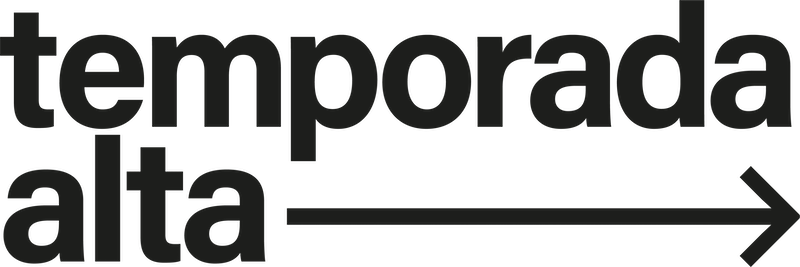2019 Edition
From the stage to the world
The 28th edition of Temporada Alta presents an extensive programme which encompasses various genres and audiences, always with the aim of putting the best European creations on stage, promoting local talent and maintaining the position of being the leading Festival in Catalonia, in Spain and in Europe. Angélica Liddell, Christiane Jatahy, Oskaras Korsunovas, Thomas Ostermeier, Marta Carrasco, Àlex Rigola and Sol Picó are just some of the stars in the line up, which, this year more than ever, raises the reality of Temporada Alta’s stage productions.
The Festival stands as one of the main platforms for the exhibition and production of performing arts in southern Europe and which maintains following lines of action:
- A central role in the exhibition of the best international creations, with companies and playwrights returning to the Festival (Angélica Liddell, Oskaras Korsunovas, Thomas Ostermeier…), others who are joining us for the first time (tg STAN and Dada Massilia) and the consolidation of the Latin American connection cycle (Christiane Jatahy, Claudio Tolcachir, Sergio Blanco…).
- Driving the production of shows with a total of 21 coproductions and productions, blending together a mixture of international and national artists.
- An exhibition of Catalan creation with names such Sol Picó, Sílvia Munt, Àlex Rigola, Clàudia Cedó, Carlota Subirós, Marta Carrasco and Sergi López.
- Encouraging young audiences through Artèria, a group designed for the under 30s which debuts this year with four shows.
- The consolidation of the social-educational programme: A Tempo – Acts i formació (Arts and Training) which reinforces the educational aspect of the festival and which, during the month of October, presents its plays at educational centres under the title of Temporada Alta a l’Aula (Temporada Alta in the Classroom).
- The promotion of meetings involving directors, companies and programmers through the Programmers’ Week, a showcase of contemporary creation.
- The consolidation of the Catalan Dramaturgy Tournament, a theatre competition which has been exported to other cities and this year includes eight playwrights competing for the first time.
- A commitment to the plurality of formats, subject matters and audiences, with musical and film proposals and a wide variety of theatre shows.
The sense of a festival
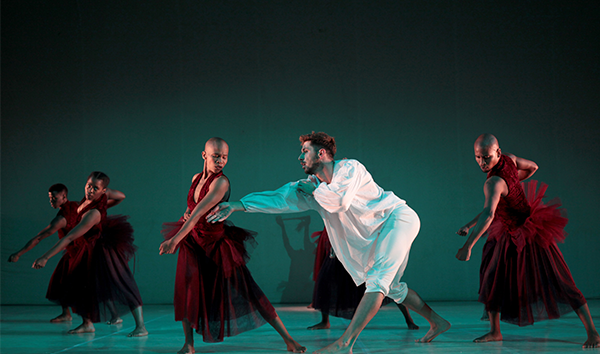
We are going through strange times which often gives us the sensation that the world is drifting and that many citizens are like disorientated puppets, following absurd voices, lacking humanity, who propose simple solutions with no future.
In a situation such as this, what sense and what use can a performing art festival offer, beyond presenting the best shows possible? In this 28th edition of Temporada Alta, with the hundreds of shows that we present, we have aimed to choose ones which help us find out where we come from, where we are and, if possible where we can head for in the future.
With this programme we present you with, we have tried not to forget that what happens in the world is what happens to people and that artists have focused their thoughts on the human condition for more than 3000 years. For this reason we have pleasure to present to you: O agora que demora, a great show about immigration based on Odissea, and Iphigenia en Vallecas a show about how the system is leaving youngsters without a future and Macbettu, a show about power… Why do people say that classics shouldn’t be made? Is there anything more contemporary than the great plays?
Looking back on where we have come from (for this reason we are so pleased to have texts by Shakespeare, Rodereda, Pinter, Lorca, Bertrana, Zweig, Walser, Verdaguer…), we are sure that we can help in the search to know a little, where we are and, who knows, even where we are going…
The Festival is designed for a wide audience and we believe that any member of the public can find a show that they will enjoy. However, Temporada Alta, as we explain in detail in this document, presents some great international shows (29 productions), alongside many Festival productions and coproductions (26) and it does so with the aim of particularly supporting contemporary creation (25) and not only textual Catalan dramaturgy (58).
As we are concerned about the future, we are sure that the arts can help us unite society and make us freer and provide us with clues as to where we can head in the future. For this reason, we initiated the A Tempo project two years ago together with the Ciutat Invisible Foundation, with which we want to ensure that all children in Girona and in Salt have free access to the world of performing arts which, for Temporada Alta is the backbone of the Festival.
Salvador Sunyer, Director of Temporada Alta
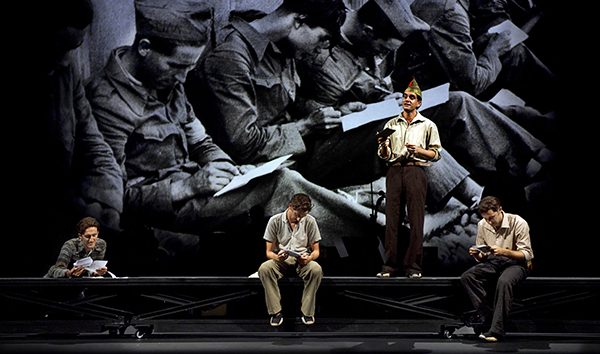
Documents
Poster 2019
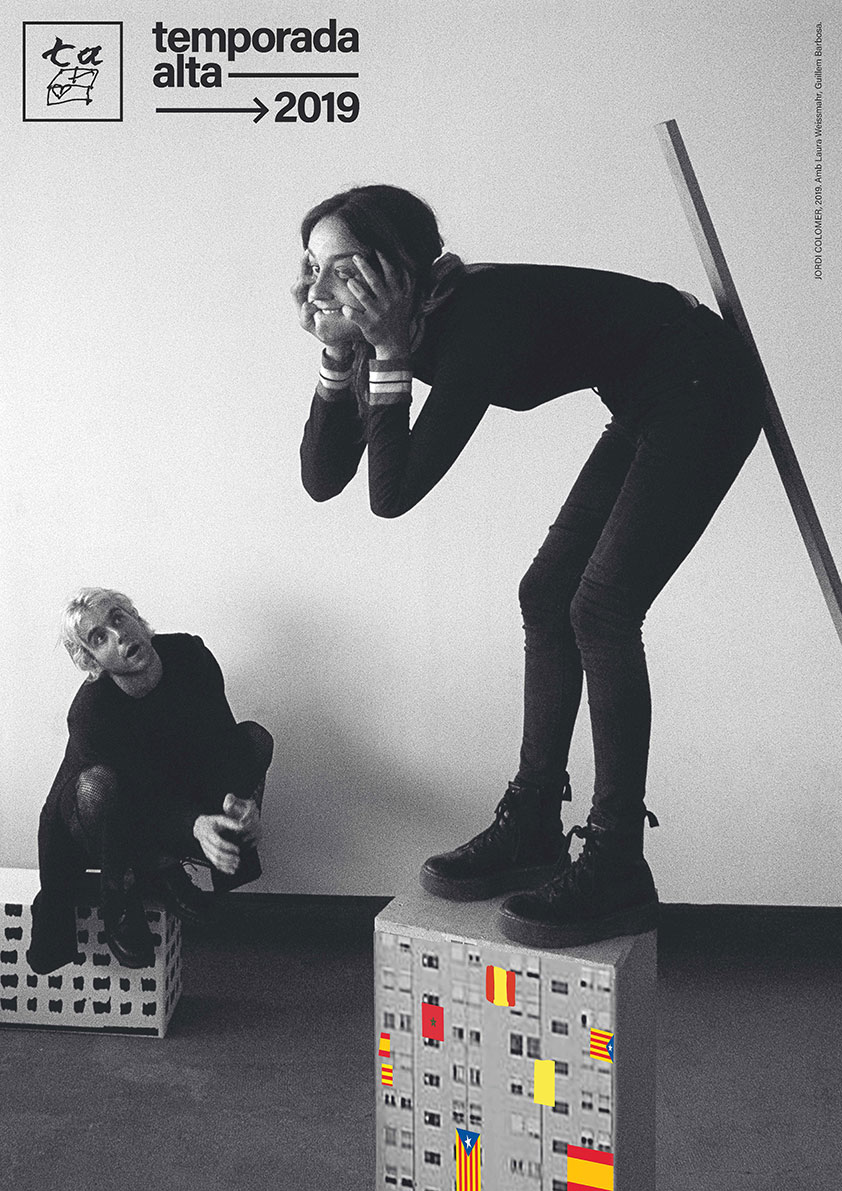
Two giants take over the public space
The posters of the successive editions of the Temporada Alta Festival make a very powerful advertisement, and also allow the multifaceted character of many of its playwrights to be observed as well as the relation they have with the performing arts, the theatre and the performance itself. The creator of this year’s poster, Jordi Colomer (Barcelona, 1962) provides a good example of this, especially when talking about the notion of an “expanded theatre”. “In my video work at the beginning everything happens in enclosed spaces and sets, and the moment I go out into the public space, the actors gradually appear as the people who live in the city”, states Jordi Colomer. “All the elements: the theatrical elements can be found in the public space: the theatrical stage is the city, the actors are the residents and if there is a fictional story, it is often improvised. We translate the theatre system to our organisation of space on a daily basis”, he stresses.
The protagonists of Jordi Colomer’s poster are the actors Guillem Barbosa and Laura Weissmahr. They appear as two giants on top of the characteristic reproductions of the buildings in his work, an alteration which for the artist reflects how reality is also “distorted”. “One of the references that I gave to Guillem and Laura was that of Karl Valentin; he is a character I have always found very interesting, because he is a mixture of everything theatrical, Dadaism and the absurd and I really like the grotesque expression of Laura’s caricature-like character”, says the artist.
Jordi Colomer has worked with Laura Weissmahr on various projects in recent years, which include the one presented at the Spanish Pavilion of the Venice Art Biennial in 2017 and the last edition of Manifesta. Laura Weissmahr has her own theatre company and is a cast member of the Elena Martín film, Julia ist. As for Guillem Barbosa, apart from his talent as a performer, he also participated in the staging of El chico de la última fila, starring Sergi López. They appeared together in the play, Wohnwagen.
Jordi Colomer has created several posters in the past and his “precedent” with regards to Temporada Alta, can be found in his previous play in 2011, Crier sur les toits (Shouting from the rooftops) which included posters announcing a party. “The posters were on the street and also in the exhibition hall; they showed people shouting from the rooftops, portraying the idea that the rooftops are like stages of the city.”
The current situation of Catalan politics seeps into Jordi Colomer’s poster through the flags which have been painted onto the building on which Laura stands. There are two pro-independence flags, two Spanish ones, the Senyera (the Catalan flag); a yellow flag, representing the demand to free political prisoners, and to give visibility to the communities living in Catalonia, a Moroccan flag too. Morocco is also one of the countries where the artist has worked in recent years. “Our country [i.e. Catalonia] is colonised by these types of signs, and it would seem that an architectural structure cannot exist without the comment of how these signs play a part, giving their opinion on political matters. We have seen the use of buildings to express the public opinions of the inhabitants for many years. In our country it is very exaggerated and very unique”, Colomer explains.
Colomer’s relationship with the performing arts goes back to the 1990s: his exhibition at Tinglado 2 in Tarragona was entitled Alta Comèdia, and it blended together sculptural works, staging elements and references to architecture. Later, he did this “on an occasional basis”, he says, the theatre staging such as in Olga Sola, by Joan Brossa, directed by Rosa Novell; Final de partida, by Samuel Beckett, also headed by Rosa Novell; Perfect lives, by Robert Ashley at the Metrònom exhibition hall, and in Carta als actors, by Valère Novarina, with the company Teatre Invisible at the Teatre Lliure. “I had known Rosa from when we had worked on the magazine Àrtics. I met her when she was rehearsing Oh, els bons dies!, by Samuel Beckett, which was the play that reaffirmed her as a major actress. I followed the process of that play and it was very important for me because I discovered, not only Beckett, but also the theatre from the inside”, Colomer recalls. He adds, “Rosa was a real actress, a real diva, but she was one of the few actresses who had some contact with contemporary art, architecture and literature.”
Jordi Colomer’s relationship with the theatre is organic and this can also be seen in his video work and his interest in public spaces. In this regard it can be said that both in his works in the streets as well as his performing arts aim to debate the use of public spaces and of their collective uses. Amongst this string of works, there is one that includes a specific theatrical reference: No singing (2012), on the megalomaniac projects of “casino-cities” in Spain during the most recent financial crisis; it includes references to Mahagonny by Bertolt Brecht, conceived at the same time in which Las Vegas was built.
Jordi Colomer represented Spain at the Venice Art Biennial in 2017 with the Join Us! Project, and a few months ago he opened La Infinita creation laboratory in Hospitalet de Llobregat together with the cultural producer, Carolina Olivares and the poet Eduard Escoffet. One of the laboratory’s aims is to bring together live and audiovisual arts. Throughout his career, Jordi Colomer has exhibited his works in museums and major national and international events such as the Arts Santa Mònica centre, the Tolosa Art Festival, the ARGOS Centre for Art and Media (Brussels), the Matadero Madrid, the Bronx Art Museum, the Laboratorio Arte Alameda (Mexico City) the Hiroshima City Museum of Contemporary Art, La Panera Art Centre (Lleida), Jeu de Paume (Paris), Manifesta, the Reina Sofia Museum, the Patio Herreriano Museum (Valladolid), the Fundació Suñol, MACBA, Artium, the Orlando Museum of Art (Florida), the Museum of Antioquia (Medellín, Colombia) and the Centro de Arte 2 de Mayo, CA2M (Móstoles, Madrid), among many others.
Playwright artists and performing artists
With regard to the relationship with the theatre of other artists who created some of the previous posters for Temporada Alta, Narcís Comadira, the designer of the 1997 poster, is also a playwright and Frederic Amat (2000) has done the staging for numerous stage shows such as La plaça dels herois and El Público, and has made numerous performances. In their shows, Carles Santos (2002) blended music, the performance and theatre and Jaume Plensa (2007) worked on operatic staging such as in La flauta màgica by La Fura dels Baus. Later, there was Antoni Tàpies (2008), of whom there is as yet no critique of his work in the theatre, Pep Duran (2016), who is also a set designer, and the staging of El dolor, by Marguerite Duras at the Catalan National Theatre (TNC) last season, with staging by Francesc Torres (2012).
Antoni Ribas
Jordi Colomer, Barcelona 1962.
Colomer works in the field of sculpture and staging installations, photography and video-art. All of his activity is tinged with a distinct performative nature, putting the conventional use of architecture and urban space to the test. Colomer takes an interest in the city’s system of representations and our ability to subvert them. From this investigation, issues come up such as those arising from nomadism, the periphery, popular imagination, humour, the community, everything ephemeral in nature, fiction and utopia.
His work has been exhibited all over the world in museums, art centres and biennials such as the Reina Sofia Museum and the Matadero (Madrid), the Jeu de Paume and the Pompidou Centre (Paris), Belvedere 21(Vienna), Bronx Museum of the Arts (New York), Arte Alameda (Mexico City), Manifesta 10 (St. Petersburg, Russia), Manifesta 12 (Palermo, Italia), 7th Biennial of Mercosul (Porto Alegre, Brazil), the Havana Biennal (Havana, Cuba), MAAT (Lisbon), Bozar and Argos (Brussels) and the ZKU, Zentrum für Kunst und Urbanistik (Berlin). He represented the Spanish pavilion at the 57th Biennial in Venice (2017) curated by Manuel Segade, with the ¡Únete! Join Us! project. Up until 2017, he resided between Barcelona and Paris. In 2018, he launched La Infinita, a creation laboratory and meeting place for visual and live arts, based in Hospitalet de Llobregat (Barcelona) together with the poet Eduard Escoffet and the producer Carolina Olivares. Colomer has also worked as a set designer on: Olga Sola (Joan Brossa), Final de partida (Samuel Beckett), Perfect lives (Robert Ashley) and Carta als actors (Valère Novarina).
He has taught numerous workshops (selection of the recent ones): 2018, A guided tour. Sandberg Instituut, Amsterdam (Holland); 2018, New Palermo Felicissima. Centro sperimentale di Cinematografia (National Film School), Palermo (Italy); 2016, Welcome to Caveland? ENSA Architecture, Paris-Malaquais, in partnership with the Théâtre Nanterre-Amandiers (Centre Dramatique National), Paris.
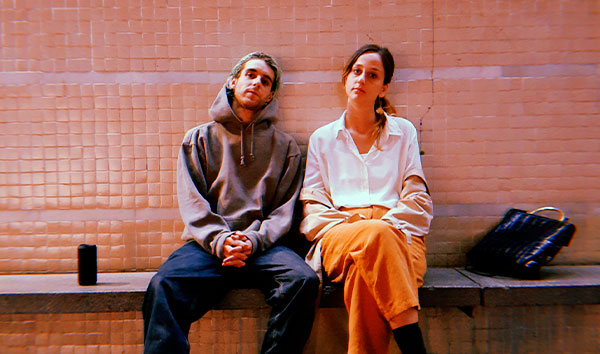
Curt 2019,THEATRE – THÉÂTRE – THEATER – TEATRO – TEATRE
As in previous editions, the Temporada Alta short film is made in close collaboration between Nanouk Films and the Festival and continues the premise of being a declaration of intent, an experimental space and a work of art in itself.
Directed by Salvador Vidal i Sunyer and with the script being written by himself along with Victor Santacana, this year the short film is the result of collaboration with the artist of the Festival’s poster, Jordi Colomer, who has worked in the field of sculpture, stage installations, photography and video-art. In fact, both the short film and the poster star the same protagonists: Laura Weissmahr and Guillem Barbosa, along with Jordi Colomer himself in a cameo role. Both the short film and the poster present the public space as an enormous theatre, in which the city is the stage and the story emerges from the forced interactions of those who reside there.
And if this year’s poster presents the public space as an eminently political one, the short film also focuses on the political aspect of a much more claustrophobic space: the underground train of a large city. Violence and onlookers’ complicity with violence is probably the main theme of a short film that puts us, the audience under the spotlight. What will we do in this situation or under similar circumstances? How long will we bear the heat? Humiliation, the property or the power (over the focus of attention, over the point of view or over the public space), as well as morbidity or the horrific narrative are some of the topics seen in one of the most claustrophobic short films of the festival.
Director’s note
“All violence always begins with an act of humiliation” – Asghar Farhadi
In recent times our society has experienced a reencounter with various types of violence and everyone has had to face an uncomfortable reality.
The short inaugural film for the 2019 Temporada Alta Festival presents itself as a hypothetical stage experience that we can be part of, in real time, during the trajectory between two train stops. Thus, the spectator is the protagonist of this brief play, in other words us, and it aims that we ask ourselves how we would act in a representation such as this one, and above all, what we should do when we witness a scene like this in our everyday lives. The theatrical fourth wall seems thicker when it deals with certain issues, and for this reason, this year we want to discuss the topic of violence and therefore humiliation, its nature and the relationship we have with it as citizens.
Without a doubt there are many types of violence and some are becoming increasingly more visible each day; but the reality is that what we would call brutal violence, if you will, has been exiled from our lives. We see it on the networks, on television, we are often told of acts of violence taking place, but it only really affects us on a personal level on a few occasions. Deep down, we know that we still have the privilege to be able to deny its existence, and it is more than likely why we are don’t know how to deal with it when it does occur. The attitude that we usually take before a violent act is usually one of doing nothing, followed by a feeling of guilt for not having prevented the aggression and in the end a bitter and silent pain which nags at our consciousness. Or not?
I believe that the theatre, as a supposedly transforming tool of society, must face this debate from a double perspective:
Can we use violence for artistic purposes with the intention of becoming better people? And, consequently, should we use it in any real situations? Is it legitimate? Is it necessary? Is it useful?
At the end of this short film, lasting just 10 minutes, we may ask why the actress Laura Weissmahr and the actor Guillem Barbosa (a couple in real life) have agreed to represent (and support) this violence. And what about us?
At the end of the day, the theatre is a space in which the actors put on a mask, and the audience take theirs off, or it is simply a mirror in which we can all look at each other.
Salvador Sunyer i Vidal. Director of Nanouk Films.
ARTISTIC TEAM
Director: Salvador Sunyer
Script: Salvador Sunyer and Víctor Santacana
Production: Nanouk Films and Temporada Alta 2019
Girl: Laura Weissmahr
Boy: Guillem Barbosa
Man: Jordi Colomer
Original music: Sergio Beltrán
Production director: Andrés Mellinas
Photography director: Toni Vidal
Art director: Yaiza Ares
Costume: Atena Pou
Makeup and hairdresser: Andrea Trenado
Film assembly: Marc Roca
Graphic design: Helena Santacana
Sound design: Diego Pedragosa
Nanouk Head of Communication: Leonor Abreu
